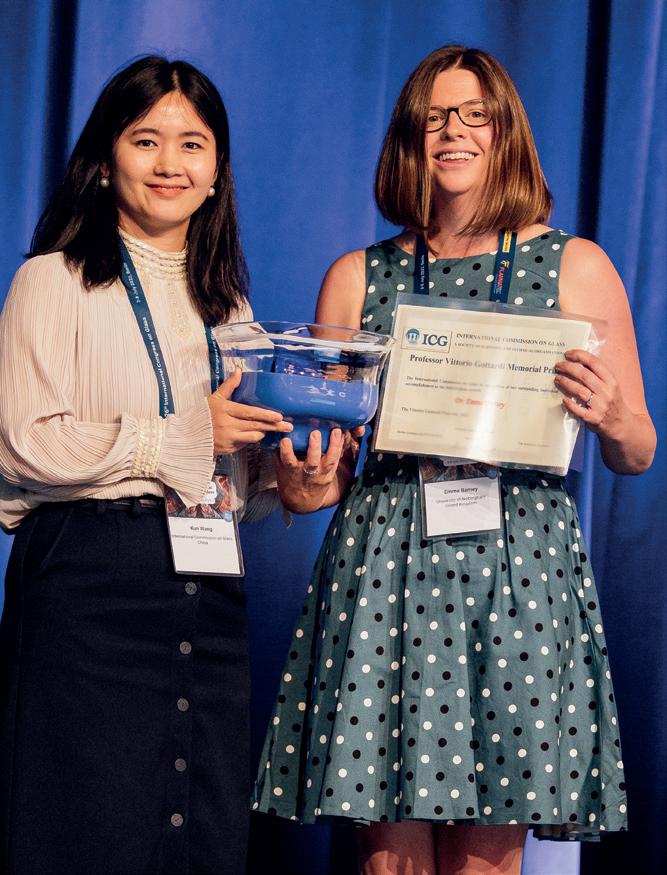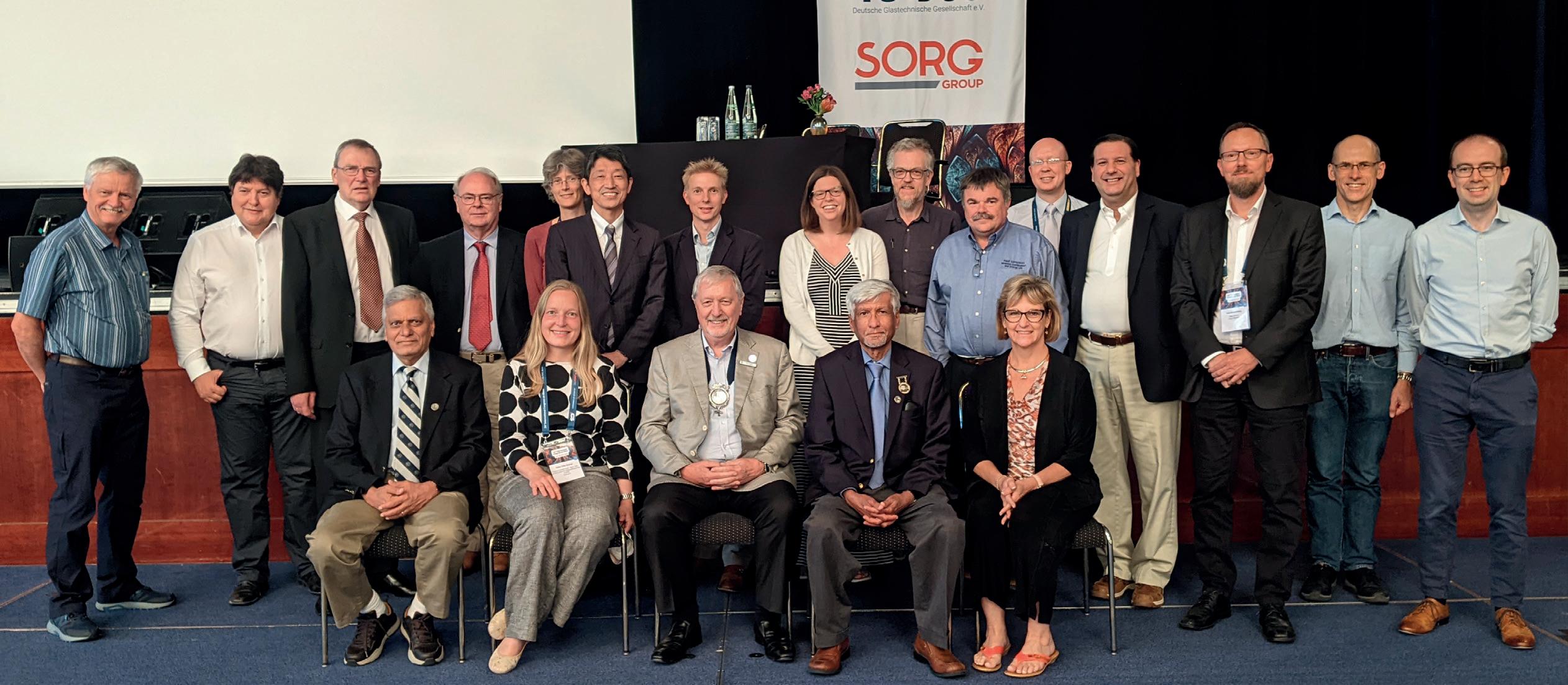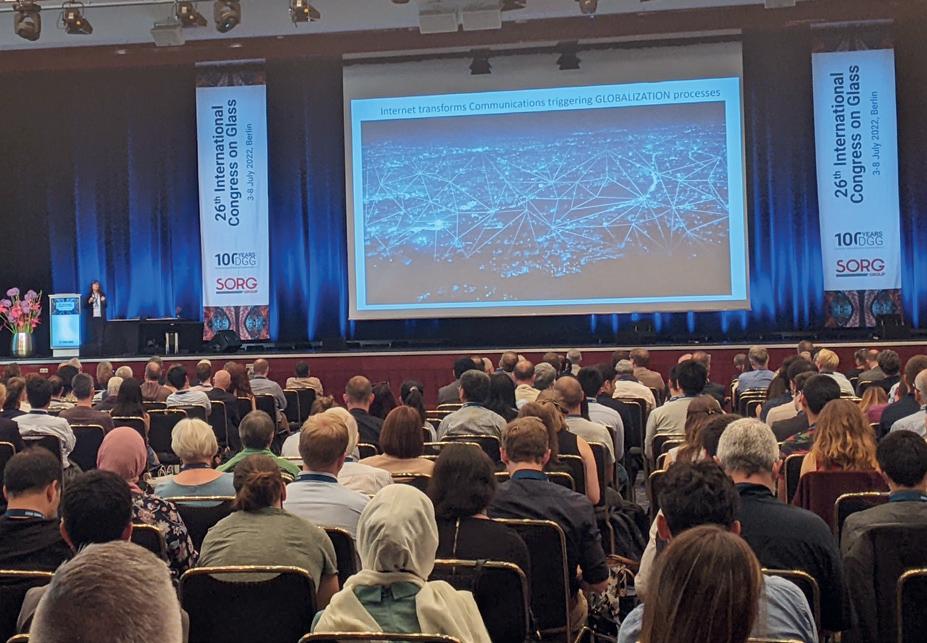
8 minute read
ICG review
The 26th International Congress on Glass (ICG) examined crucial topics facing the industry, such as the fuel for the future. Many believed there was no one option to reach net zero carbon emissions, and that every possibility would need to be explored. Jess Mills was in attendance. International Congress on Glass investigates the fuel of the future
ICG took place earlier this year at the Marriot Hotel in Berlin, Germany. The event celebrated 100 Years of the German Society of Glass Technology (DGG) as well as the International Year of Glass (IYOG). 879 participants from 37 countries attended the congress, which offered strong scientific and technical programme. This included 456 lectures and 131 posters in 38 technical sessions over the six days.
Key topics included hydrogen, electrification, decarbonisation, furnace design and recycling which were presented by companies such as Ardagh, CelSian and NSG, as well as event sponsors Schott and Sorg.
During the Opening Ceremony, Joachim Deubener (Pic 1), ICG 2022 Congress President, thanked everyone for their attendance despite the terrible situation in Ukraine as well as Covid restrictions.
He added that he appreciated the strong commitment from the industry despite the rapid change in energy sources, such as the transition to renewable fuels.
Awards
The Opening Ceremony was followed by the Otto Schott Awards, presented by Dr Matthias Muller, Executive Vice President of R&D at Schott AG.
The Otto Schott Research Award promotes innovation and achievements in glass science. This year, the awardees were nominated by the Board of Trustees of the Ernst Abbe Fund.
The winners were: Prof Alicia Durán, Research Professor at Instituto de Cermaic y Vidrio, former ICG President, and IYOG Chair; and Prof Daniel Neuville, Research Professor at Institut de physique du globe de Paris Université (Pic 2).
It was felt that both winners not only supported the primary objective of celebrating innovative glass, but also sustained contributions to fields beyond their own careers.
Prof Durán was also presented with the ICG President’s Award by current President Reinhard Conradt (Pic 3).
Mr Conradt commended Prof Durán for her intense dedication to ICG, outstanding lifetime contribution to science and technology, inspiring others and her role in IYOG. See right for further awards.

� Pic 1. ICG 2022 Congress President Joachim Deubener welcomes attendees to the conference.
Society of Glass Technology
The Society of Glass Technology (SGT) is a non-profit organisation that provides a communication network for the industry. The society held a meeting for members to sign the ‘Roll of Fellows’ book who were previously unable to due to Covid restrictions (Pic 5). The book contains the signatures of all society members and is usually only kept at the SGT headquarters in Sheffield for security.
The book was signed by Dr Julian Jones, Professor of Biomaterials at Imperial College London, Naoki Sugimoto, AGC General Manager, and Richard Brow, Curator’s Professor of Ceramic
FURTHER AWARDS
� DGG Adolf-Dietzel Industriepreis (2022) – René Limbach
� DGG Goldener GehlhoffRing (2022) – Ralf Müller
� ICG Vittorio Gottardi Prize (2020) – Juejun Hu
� ICG Vittorio Gottardi Prize (2021) – Emma Barney (Pic 4).

� ICG Vittorio Gottardi Prize (2022) – Mathieu Bauchy
� ICG Turner Award (2022) – Hande Sesigur and Delia Brauer
� ICG W.A. Weyl Award – N.M. Anoop Krishnan Engineering at Missouri University of Science and Technology, who all received certifi cation (Pics 6 & 7).
Former SGT President Stuart Hakes has now reached the end of his term. He believed the society was “well set for the future” with the next generation of glass makers beginning to join the organisation. Many members commended him for successfully leading the society despite the pandemic. Mr Hakes is succeeded by Dr Arun Varshneya, the society’s fi rst president from overseas.

� Pic 4. ICG Executive Secretary Kun Wang presents Emma Barney with the 2021 ICG Vittorio Gottardi Prize. � Pic 2 . Otto Schott winners Prof Daniel Neuville (3) and Prof Alicia Durán (4) and, alongside Prof Tanguy Rouxel (1), Prof Kathleen Richardson (2) and Dr Matthias Muller (5).


� Pic 3. ICG President Reinhard Conradt hands Prof Alicia Durán the President’s Award.
Hydrogen
Jörg Leicher, Research Engineer at the Gas & Heat Institute, described providing decarbonised process heat as one of the “biggest challenges for the industry” in his talk on hydrogen/natural gas blends in collaboration with BV Glas. He suggested full electrifi cation (providing fully green power) or green hydrogen as two possible options, but emphasised that the supply would need to be secure, effi cient and run on a 24-hour basis.
Andy Keeley (Pic 8), Principal Technologist at NSG, pointed out the potential issues when adding hydrogen to the national grid in his talk on HyNet’s IFS Firing Trials. He suggested that there would be some interruptions and variability in the hydrogen received throughout the UK, making it diffi cult to secure a reliable supply.
879

PARTICIPANTS
� Pic 5. All the Society of Glass Technology members present at the conference.
� Pic 6. Former SGT President Stuart Hakes presents Naoki Sugimoto with certification. � Pic 7. From left to right: Richard Brow, Stuart Hakes and Julian Jones with the Roll of Fellows book.

37
COUNTRIES

The Gas & Heat Institute also found similar results in Germany. A Geographic Information System (GIS) analysis found that only one site (out of nine) could be supplied with sufficient hydrogen in a 10km radius using local wind turbines - possibly three sites if the radius expanded to 20km. However, Mr Leicher said it was optimistic to assume that wind turbines could exclusively serve glass manufacturing sites; unfortunately, no site would come close for PV panels.
Consequently, Mr Leicher believed that full decarbonisation via hydrogen may require either a completely green power grid with a local electrolysis or a dedicated hydrogen grid. In the long run, he suggested that the industry should think of using 100% green hydrogen, or the emissions would be shifted elsewhere. For example, hydrogen combustion with air produces higher NOx emissions, despite hydrogen’s calorific value being a third of natural gas’s value.
In conclusion, Mr Leicher said that the glass industry would have to consider hydrogen in some capacity and highlighted that “producing huge amounts of green or at least blue hydrogen” would be the real challenge.
Biofuels
Robert Ireson, Innovation and Partnerships Manager at Glass Futures, discussed biofuels and possibility of combining biofuels and electricity in a hybrid approach.
In an availability model, it was found that 100kg to 350kg of biofuel would be required to melt 1T of glass. Therefore, around 1MT of biofuel could fuel the UK’s 3.5MT annual glass production.
So far, there have been two successful biofuel trials at Encirc and NSG Pilkington. In January 2021, Encirc used biofuel for its 400T/day container furnace at its Derrylin plant in Northern Ireland, UK. The trials ran continuous operation for three weeks without any issues
In February 2022, NSG Pilkington used biofuel for its 850T/day float furnace at its St Helens plant in the UK. The trials ran four days continuous operation with no issues.
Mr Ireson said further feasibility studies into biofuels for the glass sector were planned for this year, as well as 30T/day
� Pic 8. Andy Keeley conducting his talk on HyNet’s IFS Firing Trials. � Pic 9. Sven-Roger Kahl during his talk on sustainable packaging. � Pic 10. Andreas Emrich, Zippe, spoke on batch and cullet preheating.

� Pic 11. Bruno Purnode, Owens-Corning, discussed glass fibre manufacturing.
� Pic 14.Trevor Wilson, DSF, explored changing conditions in refractories for hydrogen and hybrid melters. � Pic 12. Hans van Limpt, Sibelco, considered energy efficient glass melting. � Pic 13. Stephen Schaller, Sefpro, examined the effect of electrical boosting on furnaces.

456
LECTURES

pilot-scale and industrial trials in 2023 to 2024. These trials will explore a range of biofuels (liquid and gaseous) as well as a hydrogen-fired pilot glass furnace.
In conclusion, Mr Ireson said that ‘no fuel was perfect’. He believed that the best fuel would depend on geography, seasonality, access to fuel and competition. He also suggested that this would vary over time. For example, biofuels are likely to be more attractive in the short term, while electric melting is more suitable in the long term. Therefore, he concluded that the best scenario will likely be a hybrid one.
Electrification
Sven-Roger Kahl (Pic 9), Furnace Operations Manager at Ardagh, also suggested that a hybrid solution would be the best approach for container glass in his talk on sustainable packaging. He said that electrification was “not yet the solution for the future” as it has a high operational cost, a shorter furnace lifetime and operational limitations in flexibility. However, he believed that these issues could be addressed, particularly if the industry were to take a hybrid approach.
Energy balance calculations (EMB) conducted by Ardagh suggested that an increase to 80% boosting was possible. Therefore, Mr Kahl said that the primary energy source would be boosting, while the least amount of hydrogen possible (around 20%) would be used as a second heat source. While electrification and on-site hydrogen demand five to eight times more electricity for the melting process, overall energy efficiency would be increased due to the high efficiency of boosting.
With thanks to ICG for their assistance in providing images. �










